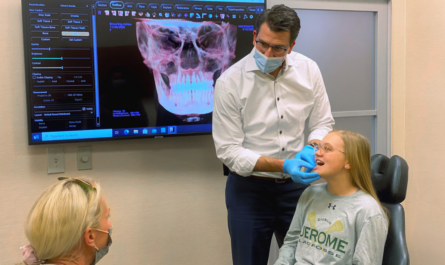Counterfeiting bigger threat than product diversion
When it comes to gray market, Bernie Teitelbaum would like to get the dental industry to break through a nagging mental image.
The enemy, he says, isn’t the gray market dealer. The enemy is the gray market product.
Teitelbaum is executive director of the Dental Industry Association of Canada. He participated on a panel called “The Dilemma and Impact of Gray Market Product Sales” at the 2015 Chicago Dental Society Midwinter Meeting.
‘A horrible term’
Traditionally, gray market products are those that are manufactured for sale in one market – say, a Third World country – often at reduced prices, but that wind up back in the country of origin.
“It is hard to put a number as to how widespread the problem is, as it ranges from unauthorized distributors diverting and re-selling product that is FDA-approved, to selling illegally diverted product that is not approved for sale in a particular market, to selling product that has expired or is compromised,” says Gary Price, president and CEO, Dental Trade Alliance.
“‘Gray market’ is a horrible term, because it’s not illegal,” says Teitelbaum. “It means you’re selling something outside the manufacturer’s authorized distribution channel.” It’s true that the manufacturer may have cause for some kind of civil action against a diverter. But selling or buying something on the gray market isn’t necessarily a crime.
Some manufacturers – primarily larger, well-funded ones – have reduced gray market trafficking of their products by changing the packaging or units of measure for products intended for other markets, says Teitelbaum. But gray marketers are resourceful. They may entice buyers with catalogs displaying photos of products intended for the domestic market, at half the cost of what traditional distribution can offer. Then they ship the product intended for distribution and consumption in other countries. “It’s a bait-and-switch,” he says.
The reason they get away with this is, most dentists typically don’t check. “They know what they want to buy, from the picture in the catalog,” says Teitelbaum. “But they don’t order it, they don’t receive it, they don’t put it in the supply cabinet or take it out and put it in the operatory.” Nor do many office managers take the time to compare the product received at the office with the one pictured in the catalog.
Though gray market activity may not be illegal, it presents potential hazards to the dental practice and its patients. Key questions arise, says Daniel Meyer, DDS, chief science officer, American Dental Association, who also participated in the Chicago Midwinter panel discussion. Where has that product been prior to the sale? How long has it been there? In what conditions was it stored? Has it been altered in any way?
“Some dental formulations are very complex,” he says. “Products may need to be protected or refrigerated, they may have limited shelf life, or there may need to be specific care in handling them.” There’s no guarantee that products distributed outside the normal supply chain can pass these tests.
A far more serious problem
All that said, the industry does have a growing awareness of gray market activities, says Teitelbaum. “Things are better, because there is a heightened awareness of it. But they’re also worse, because most of the gray market product today is unlicensed and, increasingly, counterfeit.”
Resourceful gray marketers understand that it might be simpler and more profitable to simply make fake products that look like those sold in the domestic market, rather than divert legitimate ones, he says. “The gray market is trending away from the backdoor selling of 30 years ago, to the Third World counterfeit product. It’s no longer the same product that’s manufactured here.”
Says Price, “What we have seen changing in the landscape of dental product sales is the increasing occurrence of black market and counterfeit goods. That’s a far more serious problem. With the ease of the Internet to set up shop under numerous business names to promote their products, gray market dealers are becoming increasingly emboldened in enticing the dental community with significant discounts while thinking there is not much that can be done to stop them. As a result, we have seen an alarming trend of these ‘businesses’ offering counterfeit goods to increase their sales and margins. I mean ‘alarming’ by the fact that these goods are not gray — they are illegal, which puts our members’ customers and ultimately, their patients, at risk.”
The growth in counterfeiting is an alarming development, says Teitelbaum. After all, counterfeit products are unregulated, and are either ineffective or harmful to patients. But at the same time, he sees a silver lining. That’s because, unlike selling gray market products, selling counterfeit products is clearly illegal. U.S. Customs will come down “like a ton of bricks” on counterfeiters. They will go to jail.
“I know crooks will find a way to steal, so my objective is to make it as criminal for them to do so as possible,” he says. “You reduce the number of people who are willing to do it, and at least you put some people away. So let’s see if we can nip it in the bud.”
What can be done?
The ADA’s involvement in regulatory and standards-making organizations is a crucial first step in stemming gray marketeering and counterfeiting, says Meyer.
“We work very closely with all the stakeholders – academia, government, regulatory agencies, manufacturers, scientists, researchers and others – to develop standards for the industry.” In fact, ADA works closely with the American National Standards Institute (ANSI) as well as the International Organization for Standardization, or ISO. “We try to address important issues, such as the formulation of materials, safety, labeling, expiration, shelf life,” he says. “We address these things upfront, and we work closely with all the communities of interest and stakeholders involved in developing product safeguards.”
In addition, the ADA conducts a professional product review program to assess and provide information on the performance of professional products, and a “seal of acceptance” program for the safety and effectiveness of over-the-counter dental products. What’s more, the association operates its own scientific laboratories in which it can examine products on the market.
“By being involved in the standards development and product evaluation processes, we get to know the product line inside and out,” says Meyer. “That gives us a level of expertise to identify product that might not be living up to its reputation or may not have been handled the way it should have been.”
Manufacturers can help stem the tide of gray market and counterfeit activity in a number of ways, says Teitelbaum. In addition to changing packaging and units-of-measure for products intended for sale in non-domestic markets, they can publish side-by-side photos of those products intended for consumption in the United States or Canada, and those intended for emerging markets. Of course, that’s no guarantee the dentists or office staff will study the photos and compare them to the products on their shelves.
In the end, the best defense dental practices can employ against gray marketeering and counterfeiting is a combination of buying from distributors they know and trust, and paying close attention to the products they receive from all others, says Teitelbaum.
Says Price, “On the positive side, we anticipate that the U.S. Food and Drug Administration Unique Device Identification – UDI – system will help to curb the flow of illegal gray and black market dental products. While this will result in additional costs to manufacturers, our members see it as a means to improve accountability for the lawful and intended distribution of their products.”
Meanwhile, the dialogue continues.
“When we established our Gray Market Task force in 2011, the goal was to provide a forum for both our manufacturer and distributor members to discuss what could be done about the situation,” says Price. “Today, with the rise in black market and counterfeit goods, both of which are illegal, the focus of the Task Force has broadened from working with regulators to monitor and prosecute these activities, to developing packaging that allows for easier tracking of product and its intended market to deter gray market activities.”





